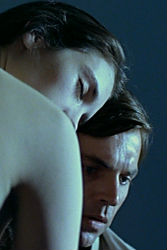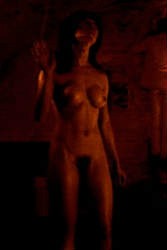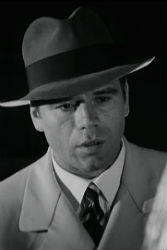DAMNATION
Béla Tarr, 1988

András Bálint Kovács on Béla Tarr’s ‘Damnation’
CAMERA MOVEMENT & MISE-EN-SCENE IN ‘DAMNATION’
Posted by kind permission of András Bálint Kovács
András Bálint Kovács is Professor & Founding Chair, Department of Film Studies, ELTE University (Budapest).
From András Bálint Kovács, The Cinema of Béla Tarr: The Circle Closes (Columbia University Press, 2013) pp. 55-59
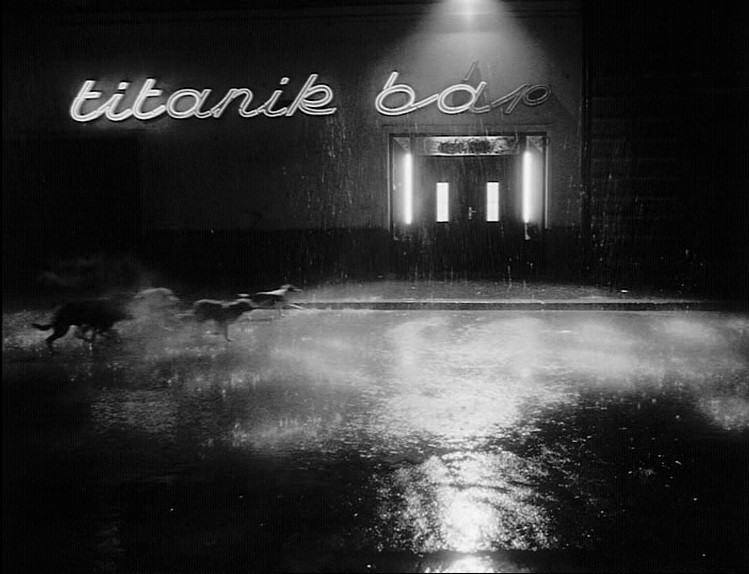
Béla Tarr, Damnation
I. DAMNATION: THE SHIFT INTO ‘SUSPENDED REALITY’
In Damnation the characters originating from a similar petit bourgeois or proletarian background as those in the earlier Tarr films suddenly started to talk in an unlikely poetic and abstract way, expressing thoughts and feelings one would not expect to hear often in this social milieu, certainly not in the earlier Tarr films. Very strange sounds and noises, certainly not coming from real-life sources, can be heard constantly during the film, and often it is difficult to tell if a given sound is diegetic or just a non-diegetic effect. The landscape is recognisable and unrecognisable at the same time. Even for someone not familiar with average Hungarian small-town scenery, the carefully designed character of the exterior views is striking.*
* BELA TARR: ‘It’s very easy to identify where those early films are taking place. They have a kind of fixed urban, contemporary reality to them, and these later films, starting with Damnation, really seem to be taking place in some kind of suspended reality. You can’t really identify the time or the location: it is going into this more cosmic, or macrocosmic, or allegorical realm.’ (‘Talking about Tarr: A Symposium at Facets’. Booklet for the Facets DVD edition of Satantango, 2008) p. 9

Damnation, Béla Tarr
It is no longer ‘Hungary in the 1970s or 1980s’, but an unspecific degraded, deserted semi-urban, semi-rural landscape on the way to slow, gradual disintegration displayed in a careful visual composition, fitted with meticulously chosen objects and architectural elements, and lit in a strong chiaroscuro style. Yet the elements are recognisably East European, bearing the signs of a destroyed tradition and an unfinished modernisation blocked halfway to completion. This is a landscape that could be found anywhere from Montenegro to Poland or from the Czech Republic to Russia. The technological level of the objects seen in the film as well as the clothes worn by the characters evoke the period of the 1970s to the 1980s.

Damnation, Béla Tarr
II. DAMNATION: THE LONG TAKE AND MISE-EN-SCÈNE
With Damnation the average shot length of a Tarr film did not just become somewhat longer, as was the case during the first period, but suddenly doubled as compared to Almanac of Fall, tripled as compared to The Prefab People, and almost quadrupled as compared to The Outsider and Family Nest. The general feeling one has about the camerawork and the mise-en-scène in Damnation is that, typically, the camera makes simple horizontal or in-depth movements in spaces in which the characters typically don’t move, or make only small movements.

Damnation, Béla Tarr
The two most characteristic, even emblematic shots of the film in this respect are the first shot, an in-depth [backward-] tracking shot…

Damnation, Béla Tarr
… and the introduction of the ball scene, a [left-to-right] lateral tracking shot.
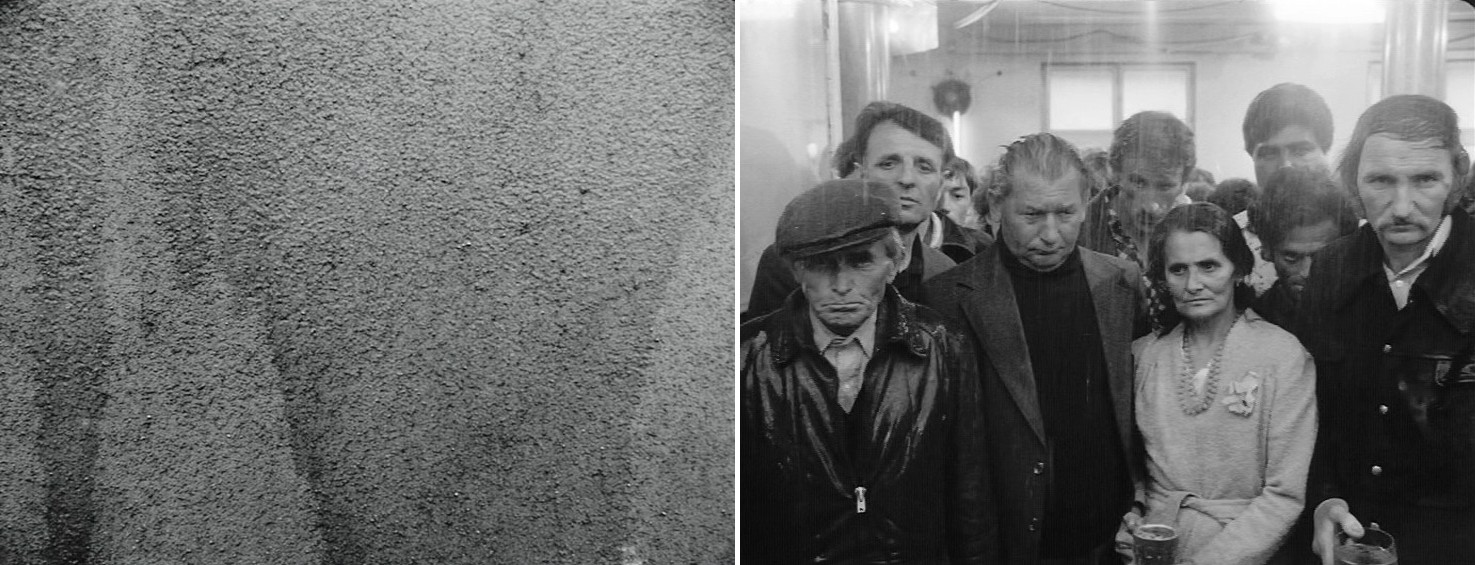
Start of lateral tracking shot, Damnation, Béla Tarr

Continuation of lateral tracking shot, Damnation, Béla Tarr
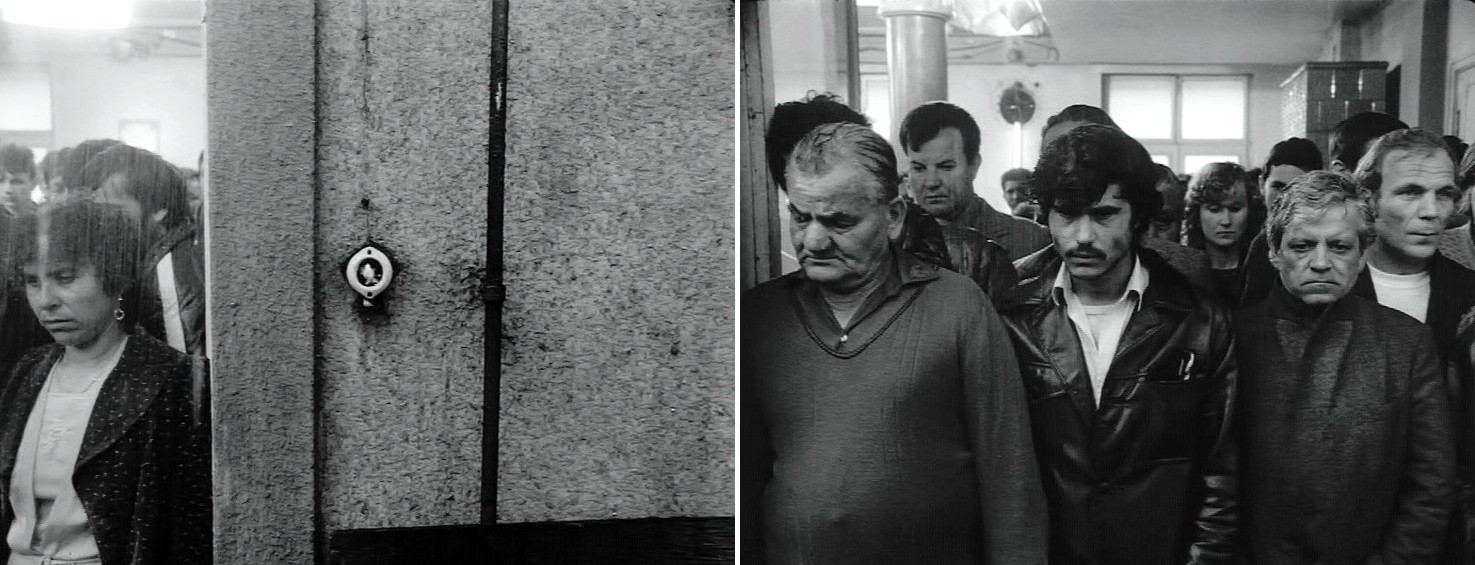
Continuation of lateral tracking shot, Damnation, Béla Tarr

Continuation of lateral tracking shot, Damnation, Béla Tarr

End of lateral tracking shot, Damnation, Béla Tarr
A very complicated combination of the two basic types is the scene at the Titanik Bar, where the camera travels on the perimeter of the circular part of a space in the shape of a half-circle, at the other end of which there is a band playing. The camera passes by clients of the bar sitting or standing immobilised on both sides of the track of the camera. The movement of this six-minute-long shot is rather complicated, since it has to turn to both sides to show the people in close-ups before it arrives at the main character’s close-up. The camera lingers for a while on Karrer’s face, then slowly turns around him to reveal the singer who, during all this time, was hidden behind a pillar. This revelation comes as a surprise, since we have already seen this pillar on Karrer’s right and we could not see the singer from his point of view.

Vali Kerekes & Miklós Székely, Damnation, Béla Tarr
In we can clearly see the pillar on Karrer’s right, yet when we move around him and look to his right from his back we can see the singer, who, from his own point of view, we couldn’t see. And as we get closer to her, the pillar disappears too. This is the kind of revelation effect Tarr already used in his earlier films, yet here the source of the surprise is the ‘magic’ of an appearance rather than the fact that the camera previously did not show a particular segment of the space.

Miklós Székely & Vali Kerekes, Damnation, Béla Tarr
The way Tarr combines his mise-en-scène with his tracking shots is definitely not the Jancsó-style combined choreography of character and camera movements. In most parts of this film the characters are stationary; it is the camera that moves among them. More than before Tarr uses depth of field in staging, which is a rather natural consequence of the long tracking shots. However, this film cannot be characterised solely by depth-of-field staging. There are many instances of it, but there are many instances of the contrary too.

Miklós Székely & Vali Kerekes, Damnation, Béla Tarr
Especially when Tarr makes a lateral tracking shot, most of the time what we can see are different flat surfaces following one another. Whether or not the image has a depth of space, the most typical effect of the mise-en-scène is the contrast of the slowly moving camera and the immobile characters. This contrast creates the feeling of someone walking slowly through a space where the people are frozen or stuck in their positions and cannot move away.

Miklós Székely, Damnation, Béla Tarr
The camera almost never follows the characters. It is consistently independent from the characters’ movements. Either the characters walk out of the frame or the camera moves away from them. When there is, however, some sort of following movement, it is very short and compensated for by other independent movements. The scene where Karrer watches his lover hidden behind a fence is a case in point. The camera first shows the shop, then slowly moves to the right, discovering Karrer hiding and watching behind the fence, then slowly moves back to the left.

Miklós Székely, Damnation, Béla Tarr
This is when the woman leaves the shop and comes towards the camera. Karrer steps forward, and both of them start walking to the right.

Vali Kerekes & Miklós Székely, Damnation, Béla Tarr
The camera follows them until they reach a road leading away from the camera position. Then the camera stops and we watch them walking away towards the background of the image, and finally they disappear in a curve.

Vali Kerekes & Miklós Székely, Damnation, Béla Tarr
But the take is not over. That is when the camera resumes its tracking to the right, but there are no characters in the frame any more. The first tracking movement of the scene, which does not follow any characters, lasts 84 seconds, the second camera movement, which follows the characters, lasts 5 seconds, and the third camera movement, which again does not follow the characters, lasts 30 seconds, and the whole scene lasts two minutes and fifty seconds. So, even in a scene in which the camera is linked for some time to the movement of the characters, 95% of the time it moves independently of them.

Damnation, Béla Tarr
This is just as in the film’s last scene, where for a short while the camera seems to follow Karrer. In fact what happens is that the camera starts a lateral movement to the left, and after a couple of seconds Karrer walks into the picture from the right, but since he is moving faster than the camera, he leaves the frame on the left. The camera continues its movement to the left at the same pace as in the beginning. Even in this case the camera’s movement is independent from the character’s movement. Comparing the film to Almanac of Fall, one can remark that of all the varieties of camerawork Tarr used there, he consistently kept the independent camera movement as his main stylistic device.

Damnation, Béla Tarr
In this respect Tarr’s staging style reminds one most of Fassbinder’s highly static theatrical staging, especially in his early period, complemented by Tarkovsky’s constantly and independently moving camerawork. The characters do not move about much in a given scene. They have a certain position relative to the space and to each other, and when they move, mostly, they move a little, for instance, out of the frame, but they very rarely run through long, complicated trajectories like in a Jancsó film. Sometimes they even seem unnaturally frozen.

The American Soidier, Rainer Werner Fassbinder | Andrei Rublev, Andrei Tarkovsky
The first love scene is a spectacular example of this. The camera starts backing up from the window, discovering first the woman silently sitting in the bed, staring into the distance. Her body is entirely motionless; not a muscle stirs on her face or body. The camera pans down her body, disclosing Karrer lying on the bed, motionless himself. The most spectacular aspect of the performance by the actress, Vali Kerekes, is that during all the time her face can be seen, which is 45 seconds, she does not blink once. Considering that the average blink rate of a normal relaxed person is 15 to 30 blinks per minute, and that a shooting situation is not exactly relaxing, we can imagine the extraordinary effort the actress must have had to make to follow the director’s instruction not to make a single movement with her body. The only sign of life is the movement of Karrer’s belly slightly rising and falling to the rhythm of his breathing, the sound of which becomes increasing loud by the end of the scene, mixing with the strange noise of the cable carts.

Miklós Székely & Vali Kerekes, Damnation, Béla Tarr
The static mise-en-scène results sometimes in character postures that are clearly artificial or theatrical. One scene starts with the image of a young woman breastfeeding a baby. This image has no narrative significance, as they do not appear again in the film, and the camera pans away from them after a couple of seconds. They contribute to creating the atmosphere of the following scene, and this narrative dysfunctionality is emphasised in the first place by the posture of the young woman, who is not looking down at her baby but rather staring upwards with an inexpressive or rather bored look. Next to her there is a television set broadcasting a soccer game. All the elements of this picture create a feeling of inadequacy and astonishing unnaturalness.

Béla Tarr, Damnation
The other example is in the ball scene, where a man recites a poem to a woman in a strangely distorted posture.
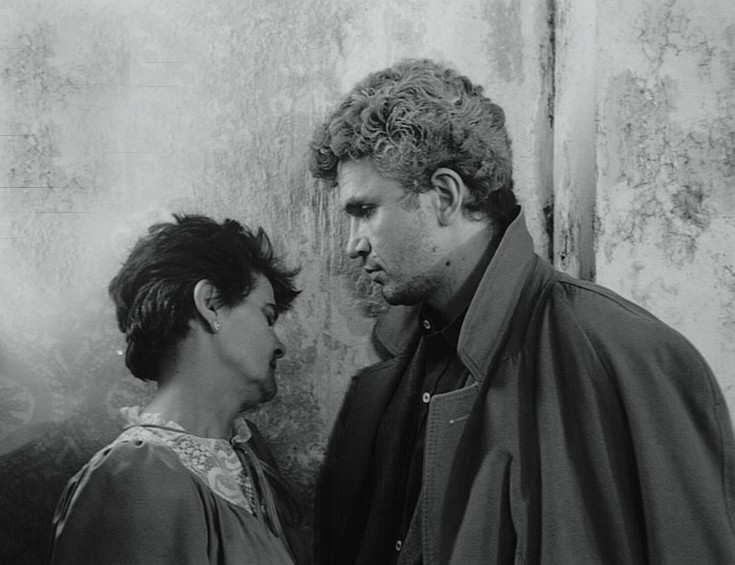
Damnation, Béla Tarr
The general motionlessness of the characters is contrasted in several scenes by mechanical movements of objects or humans. Two shots after the love scene we can see Karrer at home, staring out the window. He does not move, and the camera does not move either for the entire 27 seconds this shot lasts, but in the right-hand portion of the frame we see the carts passing by, and in the left-hand portion we can see Karrer mechanically chewing something. Here the static character of the image is in contrast with the mechanical movements on both sides of the picture.

Miklós Székely, Damnation, Béla Tarr
Other instances of mechanical motion include the first and the last shot of the ball scene, in both of which a man performs a lonely dance without the sound of music, stepping in puddles on a dirty floor. The same feeling of repeated mechanical movement is provided by several musical numbers in the film, especially in those that are played on-screen, like the accordion music, which endlessly repeats the same handful of chords.

Damnation, Béla Tarr
The world is rather static in this film; motions are repetitive, circular and have no direction. The camera moves about in this world of objects and almost frozen people sometimes in strange postures, revealing them one after the other, as if it were wandering around aimlessly in a dead landscape. In the long takes, camera movements and staging a feeling of both immersion and distanced self-consciousness are present.

Damnation, Béla Tarr
ANDRÁS BÁLINT KOVÁCS: TWO BOOKS & A CHAPTER

KOVÁCS: CHAPTER on TARKOVSKY
Film and Philosophy

ANDRÁS BÁLINT KOVÁCS
Cinema Béla Tarr

ANDRÁS BÁLINT KOVÁCS
Screening Modernism
BELA TARR, DAMNATION: TIME, DESIRE AND DIGNITY
Richard Jonathan
Rain. There’s a lot of it in Damnation, penetrating the night with a thousand truths that the wind drives into one: We are creatures of time and only desire gives us dignity. Which doesn’t mean we won’t end up in the mud, baying at dogs.

Miklós Székely, Damnation, Béla Tarr
Karrer is hopelessly in love with a married woman, a barroom singer. ‘Why can’t you love me?’ he asks her through the space allowed by her chain-locked door. ‘I love you and you know it’, she replies, then shuts the door in his face.

Vali Kerekes & Miklós Székely, Damnation, Béla Tarr
Upon a rainy night he goes to see her at the Titanik Bar. ‘It’s finished, it’s all over’, she sings, ‘and there won’t be another’. The song is a lament for a lover that’s gone, an affair that’s come to an end. As Karrer listens to it, one imagines him inserting himself into the circle of desire, one more bobbing horseman on the merry-go-round of love. Where’s the dignity in that? Perhaps it lies in the fact that love individualizes us (the lover on his horse is a rider on the storm, not a fool going round and round), making us creators and not mere creatures. Creators of what? A new illusion: that we can escape time, stay dry between the raindrops.

Miklós Székely, Damnation, Béla Tarr
Desire, indeed, causes a gap in time, separating our individual self from our social self and thereby making us, as the mystics would say, one with the ‘real’, not the veiled, world, or, as the existentialists would put it, making us ‘authentic’. (Note that neither ‘real’ nor ‘authentic’ can dispense with quotation marks, as both philosophy and psychoanalysis amply demonstrate). Despite Karrer’s scheming and betrayal, the fact that he nurses his desire, protecting it like a flame from the rain, gives him a certain dignity.

Vali Kerekes & Miklós Székely, Damnation, Béla Tarr
‘Between you and a world forever out of reach, there is a strange and empty tunnel. You’re standing alone at the entrance to the tunnel, because you know something I can’t even put a name on, something deeper and more ruthless than I could ever understand.’ So saying, Karrer seduces the singer. Then, slow and easy, they make love. Afterwards, while she takes a bath, he stands at the window, looking at the rain: It’s always back to the rain.

Vali Kerekes & Miklós Székely, Damnation, Béla Tarr
‘I realize that I can never get closer to that world. I can only long for it, because it is hidden by a light and warmth that I cannot bear. I have never been able to believe in it, nor to renounce it.’ So says Karrer. Is there not dignity in that?

Miklós Székely & Vali Kerekes, Damnation, Béla Tarr
To share in that dignity, as a viewer of Damnation, is exhilarating, for in a world where human life is ironic—nothing can assuage our desire, yet without desire we are nothing—perseverance in lucidity is liberating. Yes, for a song—a hauntingly beautiful song like Mihály Víg’s ‘Kész az Egész’—I, for one, am willing to become a fool of time. For therein lies my dignity.

Vali Kerekes, Damnation, Béla Tarr
MARA, MARIETTA: A LOVE STORY IN 77 BEDROOMS
A literary novel by Richard Jonathan
BÉLA TARR: INTERVIEW
Interview by Jonathan Romney, 2001 (Translation: László Hackenast)
From Roger Crittenden, Fine Cuts: The Art of European Editing (Focal Press, 2006) pp. 229-231
The Hungarian director, Béla Tarr, has created a radical cinema which subverts conventional narrative and amongst other things ignores continuity as an editing device. His partner, Agnes Hranitzky, is also his editor and co-filmmaker. Their films are built on long takes usually involving considerable camera movement, which at one level are reminiscent of that other Hungarian radical Miklos Jancsó. Yet there is something more disturbingly everyday about the milieu conveyed by their work. Their relationship with the composer is particularly unusual—more akin to the way animators work in the fact that the music is written before the film is shot.

Damnation, Béla Tarr
It’s very difficult to talk about what we really think to be a film. The question really is what is film for? It’s a long time since we came to the conclusion that film is not about telling a story. It’s function is really something very different, something else. So that we can get closer to people, somehow we can understand everyday life. And that somehow we can understand human nature, why we are like we are.

Damnation, Béla Tarr
We believe that apart from the main protagonists in the film there are other protagonists: scenery, the weather, time and locations have their faces and they are important, they play an important role in the story.

Damnation, Béla Tarr
From the very beginning the way we handled time was probably different from other films. First of all because we cut and edited the film differently. Most films are edited in the way pieces of information are edited—we didn’t do it that way. We pay more attention to the internal, psychological processes. And we concentrate on the personal existence and the personal presence of the actors and actresses. That is why meta-communication is so important, indeed is more important than verbal communication. And from here it is only a short step to put it in time and space.
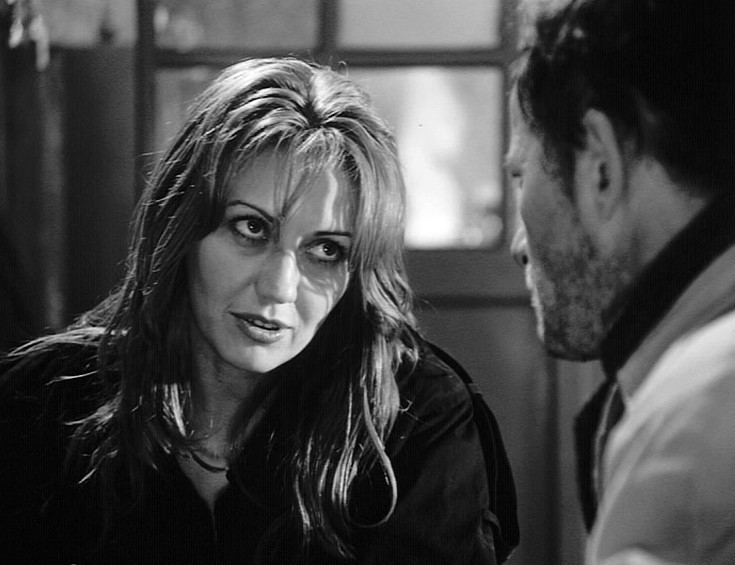
Vali Kerekes & Miklós Székely, Damnation, Béla Tarr
There is a huge difference between literature and film. They use two different languages. Writers have much wider opportunities in terms of writing hundreds of sentences and they can invoke feelings in a much more varied way. Film in itself is quite a primitive language. It’s made simpler by it’s definiteness, by it’s being so concrete, and that’s why it’s so exciting. It’s always a challenge to do something with this limited language. The writer Krasznahorkai always says ‘How can you do anything with such limited options, with such limited tools?’ He is exasperated by the fact that we, as he sees it, deal with such cheap things. Film is a cheap show in the marketplace and it’s a great thing that we can develop that into something valuable.

László Krasznahorkai & Béla Tarr
Agnes Hranitzky, my partner and editor, is present all through the making of the film. She is co-author and no decisions are made without her. Not only because she really knows and understands things, because we do work together, we make the films together. There is an everyday process of making these films with the preparations, the shooting and the editing.

Agnes Hranitzky & Bela Tarr, Berlin Film Festival, 2011 — Photos: Gerhard Kassner for Berlinale
Damnation, Bela Tarr
MIHALY VIG, MUSIC
András Bálint Kovács, Béla Tarr, Mihály Víg, Anna Szemere

Mihály Víg, 2003 | Béla Tarr, 2011
DAMNATION SOUNDTRACK: MIHALY VIG, COMPOSER
You can listen to the tracks in full with a registered Spotify account, which comes for free.
Béla Tarr was looking for a composer in the alternative rock community of the early 1980s. Mihály Víg was a member of the underground rock group Trabant, formed in 1980. The group did not last long but became incredibly popular in young intellectual and avant-garde circles. He found Mihály Víg’s music appealing, as it is minimalist, slow, sad and sentimental. It is also very simply orchestrated, mainly based on piano and accordion, and so is a mixture of cheap traditional pub music and sophisticated contemporary repetitive music.
András Bálint Kovács, The Cinema of Béla Tarr: The Circle Closes (Columbia University Press, 2013) pp. 18-19

Mihály Víg in 1981 | Photo: Fortepan / Urbán Tamás
BÉLA TARR: ‘There is another very important member of the family and that’s Víg Mihály, the composer with whom we have worked together for the past fifteen years. And without the composer the films wouldn’t be what they are. He goes into the studio a month before the actual shooting takes place, composes the music, gives it to us and then we use the music during the shoot. So the music plays an equal role to the actors or the scenes or the story. And we trust him so much that we don’t go there into the studio. He composes the music and brings the music to us. It’s a very close and very profound, very friendly relationship which has been shaped over the last fifteen years and it’s a relationship where we don’t need to talk about anything serious. We never talk about art, we never talk about philosophy, we don’t discuss aesthetics. We always talk about very concrete, very practical issues’.
‘Béla Tarr Interviewed by Jonathan Romney’ (translation: László Hackenast) in Roger Crittenden, Fine Cuts: The Art of European Editing (Focal Press, 2006) p. 231.

Mihály Víg, 1992 | Photo: Dávid Lukács
It may sound strange that the music is composed even before the shooting starts. This means that Víg’s work is not based on the actual images. Rather, the opposite is true. Tarr uses the composed music while actually shooting the film. He knows which scenes will be accompanied by music, and when they are shooting this particular scene they play the music. Very often the music during shooting helps in creating the exact rhythm of the long and complicated camera movements.
András Bálint Kovács, The Cinema of Béla Tarr: The Circle Closes (Columbia University Press, 2013) p. 67

Mihály Víg, c.2010
MIHÁLY VÍG: More than thirty years ago now, Béla Tarr organized a film club and a video workshop at the Kassák Community Center, in Budapest. There, he surrounded himself with young people who were interested in film. At that time, Béla was a very young, but already successful director. Thanks to him, we were able to watch the classics of film history, and also some masterpieces that had never had an official release in Hungarian film theaters. We were a small group of passionate cinephiles and, besides watching movies, we had the opportunity to use a portable video camera, which was very rare in Hungary in the early ’80s. The members of the group (about fifteen people in total) could use this machine in order to make their own films.
IMDB v2.1 Internet Media Discussion Boards

Béla Tarr, 1983
MIHÁLY VÍG: My friend Zoltán Gazsi was an active participant in Béla’s workshop. With that video camera he used to record the concerts of many Hungarian alternative rock bands, including my own band, Balaton. I also played in another band, Trabant. Back then, Trabant did not play live concerts: we spread our music on home-made samizdat tapes. One day Béla listened to one of our tapes, and he liked one of our songs so much that he asked Zoltán to contact me. Béla welcomed me in his apartment, together with his wife, Ágnes Hranitzky. I remember that a bottle of champagne was on their table. I had met Béla at the film club many times before and we had already been introduced, but that was the day when we really got acquainted. Béla and Ágnes told me that they were preparing a new film, Almanac of Fall, and they asked me if I would compose the music for it. I daringly accepted, and I have been writing music for all their films ever since.
IMDB v2.1 Internet Media Discussion Boards

Marietta Méhes & Mihály Víg
Originally two separate groups [featuring Mihály Víg], Trabant and Balant worked and performed in symbiosis. A unique feature of the two groups’ repertoire was that many of the songs were sung sometimes by a woman, Marietta Méhes, at other times by Mihály Víg, the male singer, guitarist, and composer of many of the songs. The songs’ ability to articulate both male and female subjectivity challenged prevailing stereotypes of feminine and masculine. The unisex character of the songs underscored the common experience of women and men in the social group.
Anna Szemere, Up from the Underground: The Culture of Rock Music in Postsocialist Hungary (Penn State University Press, 2001) pp. 63

Marietta Méhes
Trabant never gave concerts but produced homemade, rather rudimentary recordings and circulated them among their friends. Balaton’s concerts had the air of intimacy and introversion of a group of friends playing at home. Their overall musical/artistic stance owed a debt to the Velvet Underground, the New York art rock band of the late 1960s associated with Andy Warhol. The shows took advantage of visual media in a way that obscured the boundaries between performance and real life. The lyrics, like the projected slides, chronicled the musicians’ own lives, whereas their everyday lives seemed to have been self-consciously fashioned and stylized in accordance with pre-existing ideas and images. Trabant’s policies of withdrawal from public appearance thus corresponded to the secluded world created and sustained by their expressive forms and media.
Anna Szemere, Up from the Underground: The Culture of Rock Music in Postsocialist Hungary (Penn State University Press, 2001) pp. 64

The Velvet Underground: Lou Reed, Sterling Morrison, Nico, Maureen Tucker, John Cale
The individual numbers in their repertoire constituted a flow of loosely related, poetic narratives and mini-dramas. They spoke about the minutiae of daily life—thus suggesting that life consisted only of minutiae, not genuine events. The songs highlighted the precariousness of the boundary between the real and the unreal, the plastic and the authentic, the ordinary and the special. The music was unsettling: the predominantly soft, pastel-toned sound and descending melodic lines were counteracted by screeching and faltering guitar riffs. Banal poetic and musical clichés were freely used but they became suffused with fresh significance as the songs explored the uncharted territory of everyday life and the fine texture of feelings, desires, and dreams. An unexpected twist in a poetic stock phrase, the insertion of an inappropriate word or the use of paradox abruptly destabilized the meaning of conventional pop rhetoric. The blurring of distinctions between the real and the unreal produced a special ambience, rife with ambiguity; a sensation of floating in a self-enclosed space suspended in time. Isolation and estrangement were predominant themes of the songs, even as the characters of the narratives were entangled in webs of intimate relationships.
Anna Szemere, Up from the Underground: The Culture of Rock Music in Postsocialist Hungary (Penn State University Press, 2001) pp. 65

Trabant – Balaton – Marietta Méhes – Mihály Víg, c.1983

